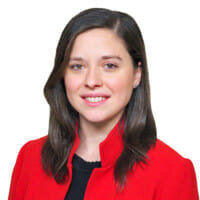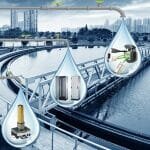The aerospace engineer turned intrapreneur
Andrea Ruotolo, Global Lead, Distributed Energy Systems, Worley
Andrea Ruotolo was attracted to the field of engineering by her aspiration to work with NASA. After she finished her undergraduate studies in aeronautical engineering in her home country of Argentina, she went to Madrid Polytechnic University in Spain for her master’s degree in aerospace engineering. There, she began working in a wind tunnel, analyzing wind turbine blades.Getting hands-on with renewable generation technologies, rather than rockets, was when her passion for the energy transition took off.
“Working in Spain, I realized that the energy transition is one of the biggest challenges facing humanity today,” recalls Ruotolo. “I knew I wanted to be part of the solution, so after my master’s I went on to study smart grid development, and completed my PhD in energy and environmental policy, focused on microgrids.”
After working as a Senior Program Manager for the New York State Smart Grid Consortium, and starting her own smart grid consulting company, Ruotolo now serves as Worley’s Global Lead in Distributed Energy Systems. Her role is focused on spearheading strategy, developing teams, proving new concepts and scaling these to capture new market opportunities and accelerate the energy transition.
This role is focused on intrapreneurship, which is like entrepreneurship – building new teams, capabilities and market offerings – but in a large, established company.
“As it turns out, one of NASA’s main areas of work is tracking climate change, which is one of the key drivers of the energy transition,” smiles Ruotolo. “So, in a way I’ve ended up where I wanted to be at the start; working alongside NASA on critical planetary and climate issues.”
What drives Ruotolo is her fundamental belief that there’s nothing more essential to our modern way of life than building a sustainable energy future for all.
“Without energy we couldn’t maintain our growing urban population or global economy,” says Ruotolo. “But the fossil energy we’ve used to get us here won’t get us to where we need to go next. We have a one-time opportunity to carry out the energy transition and get it right. We need to work quickly to reduce dependence on fossil energy and adapt to new climate conditions.
“This is a complex effort that includes an array of renewable energy technologies and advanced systems, including artificial intelligence, to accelerate better decision making and improve resource efficiency.”
Ruotolo acknowledges that this is a huge job, and that we’ll need to approach engineering and project planning in entirely new ways. That’s why, for Ruotolo, it has never been more important to stay open to new possibilities, and stay agile when it comes to technologies, processes and business models.
“The not-too-distant future will look more different than we can imagine,” says Ruotolo. “We must stay open to trying new things, prioritize learning, and never fear failure.”
Ruotolo shares her favorite quote.
“The best way to predict the future is to create it,” says Ruotolo. “But I would add ‘together’ to that.”
The determined data scientist
Jo-Anne Ting, Lead Data Scientist, Arundo
It’s 2003. Google is fast becoming a household name. Apple has made digital music downloads legal. And Jo-Anne Ting is kick-starting her career in machine learning.
“I was convinced I was going to be a professor,” laughs Ting. “But after a bachelor’s in computer engineering, a PhD in computer science and a couple of years working on machine learning algorithms in academia and corporate research, I ended up at start-ups because, for me, research was too narrow in scope and corporate was too slow.”
Now at Arundo Analytics, Ting is excited to be back in the engineering game, working alongside other engineers in the energy sector.
“The energy industry and digital go hand-in-hand, particularly as the industry shifts and starts to focus on energy alternatives and sustainability,” says Ting. “Data and technology have a key role to play in determining what we can do better and how we can find an optimal path forward.”
But it’s not going to be easy.
“There is a big safety factor in terms of people and the environment that you need to consider in the energy industry,” says Ting. “The decisions you make, the models you choose and the problems you solve all have real impact. A dire impact, if it’s not right.
“A large part of machine learning and data science is understanding the context and situation.”
That’s why, Ting believes it’s important to bridge the gap between engineers and data scientists. To make sure they’re solving the right problems and not spending time on the ones that can’t be solved.
“What keeps me going is that I don’t think we need to solve a master ‘holy grail’ problem to digitally transform the industry,” says Ting. “I think how the energy industry moves to digital is through smaller problems that are repeatable, relevant and, as a standalone problem, resonate with people. The more people you have using a solution, the easier it is to propagate adoption.”
So, when technology claims to solve all of the industry’s problems, Ting errs on the side of caution.
“Data science isn’t magic,” says Ting. “It’s math and science. If it sounds too good to be true, it usually is.”
The energy innovator
Sundus Cordelia Ramli, Regional Director, New Energy, Worley
As a student of astrophysics, it was puzzling for Sundus Cordelia Ramli to see that most of our energy was still coming from beneath the ground when there was an abundance of energy on earth and in space.
“I was equally concerned about climate change and I wanted to work towards finding a solution,” says Ramli. “This led me to my career in renewable energy. I went from a scientist to engineer. And moved on from studying the photon, to looking for new ways to apply it.”
For Ramli, this is what makes energy an incredibly exciting industry to be involved in.
“The energy landscape is evolving,” says Ramli. “The cost of production is falling, making renewable energy much more competitive. Wind and solar technology continue to improve. The decarbonization of the heat and transport sector is accelerating developments in battery storage technologies, hydrogen and high-temperature heat pumps. And technologies like smart grids, demand response and blockchain are opening up new frontiers for the energy system.”
Ramli continues.
“No matter which camp you sit in, we all need to care about the energy transition. The global demand for energy is set to more than double, while at the same time, there’s an increasing need to move to a low carbon future.”
So, when we asked, “how does the world deal with this challenge?”, Ramli’s advice is to keep on innovating.
“Innovation has been the one constant companion of the energy industry,” says Ramli. “The best part of my job is seeing the passion and ingenuity of my colleagues to increase the value proposition of renewable energy by combining digital technology with solutions and learnings from the oil and gas industry.”
One example of this has been the adoption of reliability centered maintenance (RCM) in offshore wind.
“RCM is typically used in aviation and offshore oil and gas,” explains Ramli. “But when we applied it to offshore wind the results were astonishing. We identified hundreds of millions of dollars of savings across the operational lifetime of offshore wind assets. This demonstrated how, by just steering away from the normal planned maintenance regime, we can increase the value proposition of the offshore wind industry.”
Ramli smiles.
“It’s solutions and thinking like this that get me excited for the future.”







